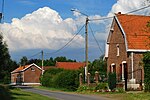Canton of Armentières
Cantons of Nord (French department)Nord (French department) geography stubs

The Canton of Armentières is a canton of the Nord département in France. Since the French canton reorganisation which came into effect in March 2015, the communes of the canton of Armentières are: Armentières (chief town) Bois-Grenier Capinghem La Chapelle-d'Armentières Deûlémont Erquinghem-Lys Frelinghien Houplines Pérenchies Prémesques Warneton
Excerpt from the Wikipedia article Canton of Armentières (License: CC BY-SA 3.0, Authors, Images).Canton of Armentières
Rue Victor Vigneron, Lille
Geographical coordinates (GPS) Address Nearby Places Show on map
Geographical coordinates (GPS)
| Latitude | Longitude |
|---|---|
| N 50.674166666667 ° | E 2.9077777777778 ° |
Address
Rue Victor Vigneron
Rue Victor Vigneron
59930 Lille
Hauts-de-France, France
Open on Google Maps










